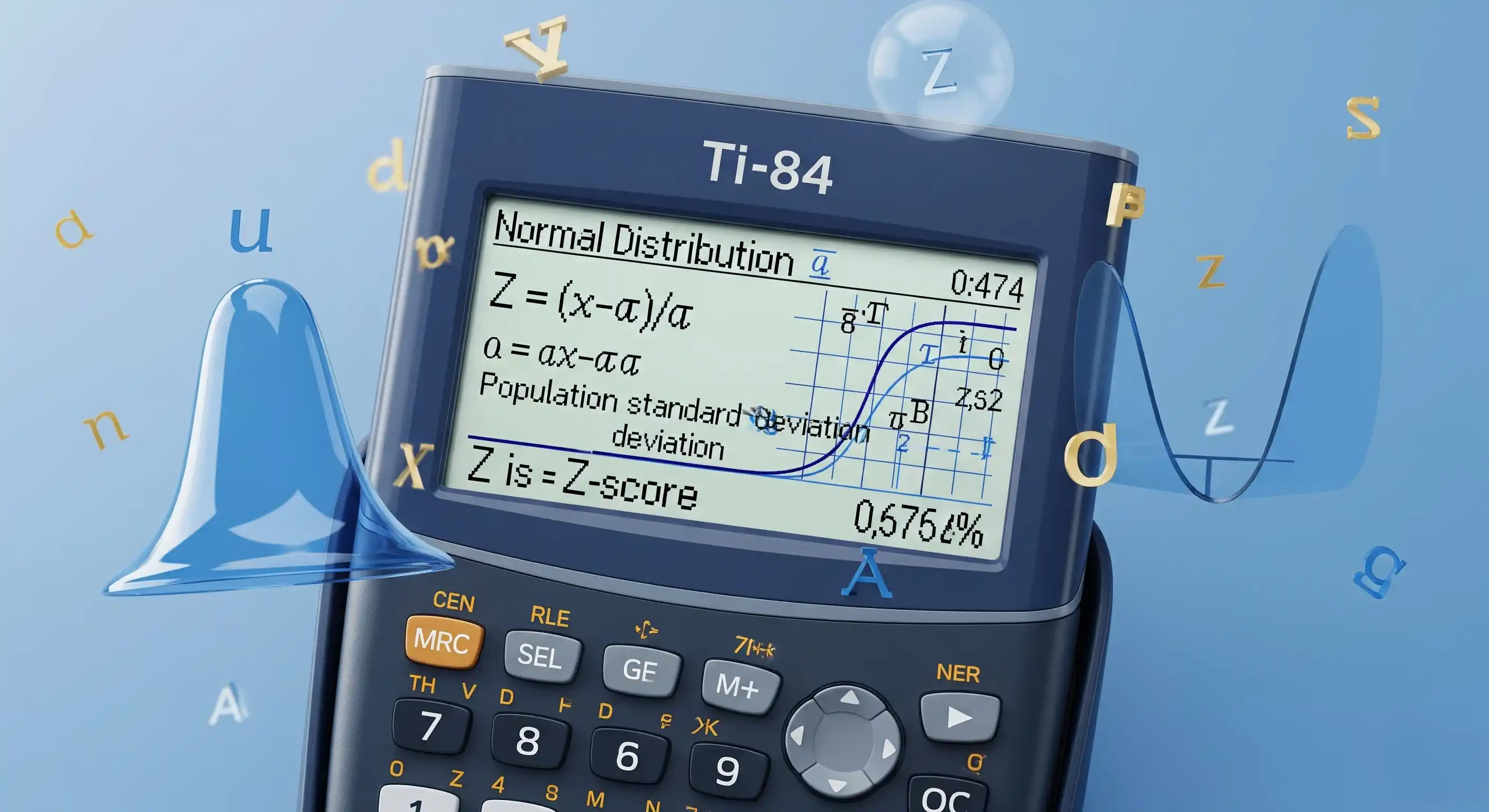Z-scores are fundamental to understanding statistics and probability. They tell us how many standard deviations a data point is from the mean, allowing us to compare values from different distributions and calculate probabilities. Your TI-84 calculator makes Z-score calculations quick and accurate.
This tutorial will teach you multiple methods to calculate Z-scores, work with normal distributions, and interpret results for real-world statistical analysis.
📖 Table of Contents
- Understanding Z-Scores: Quick Statistical Foundation
- Method 1: Manual Z-Score Calculation
- Method 2: Using the normalcdf Function
- Method 3: Creating a Z-Score Program
- Finding Probabilities with Z-Scores
- Real-World Z-Score Applications
- Z-Score Tables vs TI-84 Calculator
- Common Z-Score Mistakes to Avoid
- Advanced Z-Score Applications
- Using invNorm for Reverse Calculations
Understanding Z-Scores: Quick Statistical Foundation
A Z-score (also called a standard score) measures how many standard deviations a data point is away from the mean of its distribution. It standardizes different datasets, making them comparable.
Z-Score Interpretation
- Z = 0: Value equals the mean
- Z > 0: Value is above the mean
- Z < 0: Value is below the mean
- Z = ±1: Value is 1 standard deviation from mean
- Z = ±2: Value is 2 standard deviations from mean
- Z = ±3: Value is 3 standard deviations from mean (rare)
Method 1: Manual Z-Score Calculation
The most straightforward method involves entering the Z-score formula directly into your TI-84 calculator.
Step-by-Step Manual Calculation:
- Identify your values:
- X = your data value
- μ = mean of the distribution
- σ = standard deviation
- Enter the formula: (X - μ) ÷ σ
- Press ENTER to calculate
- The result is your Z-score
📊 Example 1: SAT Score Analysis
Problem: You scored 1250 on the SAT. The mean SAT score is 1050 with a standard deviation of 200. What's your Z-score?
Solution:
- X = 1250, μ = 1050, σ = 200
- Enter: (1250 - 1050) ÷ 200
- Calculate: 200 ÷ 200 = 1.0
🎯 Interpretation:
Z = 1.0 means your SAT score is exactly 1 standard deviation above the mean. This is better than approximately 84% of test takers.
Calculator Screen Example:
1
Z-score = 1.0 (one standard deviation above mean)
Method 2: Using the normalcdf Function
The TI-84's built-in normalcdf function can help you find probabilities associated with Z-scores and work backwards to find Z-scores from probabilities.
Accessing Normal Distribution Functions:
- Press 2nd + VARS (DISTR menu)
- Select normalcdf( (option 2)
- Enter parameters: normalcdf(lower, upper, mean, std dev)
- For standard normal: normalcdf(lower, upper, 0, 1)
Finding Probability from Z-Score
Once you have a Z-score, you can find the probability of getting that value or less:
📊 Example 2: Probability Calculation
Problem: What's the probability of getting a Z-score of 1.5 or less?
Solution:
- Press 2nd + VARS
- Select normalcdf(
- Enter: normalcdf(-99, 1.5, 0, 1)
- Result: 0.9332 (93.32%)
🎯 Interpretation:
93.32% of values fall at or below Z = 1.5 in a standard normal distribution.
normalcdf Function:
.9331927987
Probability = 93.32%
Method 3: Creating a Z-Score Program
For frequent Z-score calculations, you can create a custom program on your TI-84:
Creating the ZSCORE Program:
- Press PRGM → NEW
- Name it "ZSCORE"
- Enter the following code:
:Disp "ENTER VALUE"
:Input X
:Disp "ENTER MEAN"
:Input M
:Disp "ENTER STD DEV"
:Input S
:(X-M)/S→Z
:Disp "Z-SCORE="
:Disp Z
:Disp "PROBABILITY="
:normalcdf(-99,Z,0,1)→P
:Disp P
To run the program: Press PRGM, select "ZSCORE", and press ENTER.
Finding Probabilities with Z-Scores
Z-scores are most powerful when combined with probability calculations. Here are common probability scenarios:
| Probability Type | Formula | TI-84 Command |
|---|---|---|
| P(Z < z) | Area to the left of z | normalcdf(-99, z, 0, 1) |
| P(Z > z) | Area to the right of z | normalcdf(z, 99, 0, 1) |
| P(a < Z < b) | Area between a and b | normalcdf(a, b, 0, 1) |
| P(Z = z) | Exactly equal (always 0) | 0 (continuous distribution) |
Real-World Z-Score Applications
📊 Example 3: Quality Control in Manufacturing
Scenario: A factory produces bolts with mean length 10.0 cm and standard deviation 0.2 cm. A bolt measures 10.5 cm. Is this unusual?
Solution:
- Calculate Z-score: (10.5 - 10.0) ÷ 0.2 = 2.5
- Find probability: normalcdf(2.5, 99, 0, 1) = 0.0062
- Only 0.62% of bolts are this long or longer
🎯 Business Decision:
This bolt is highly unusual (Z = 2.5). The manufacturing process may need adjustment as this occurs less than 1% of the time.
📊 Example 4: Medical Test Results
Scenario: Blood pressure readings are normally distributed with mean 120 mmHg and standard deviation 15 mmHg. A patient has 145 mmHg. How does this compare?
Solution:
- Z-score: (145 - 120) ÷ 15 = 1.67
- Percentile: normalcdf(-99, 1.67, 0, 1) = 0.9525
- This patient is in the 95th percentile
🎯 Medical Interpretation:
This blood pressure is higher than 95% of the population, indicating potential hypertension that warrants medical attention.
📈 Practice Z-Score Calculations
Ready to master Z-scores? Use our free online TI-84 calculator to practice these techniques and work through more statistical problems.
📊 Practice NowZ-Score Tables vs TI-84 Calculator
Traditional statistics courses use Z-score tables, but your TI-84 calculator offers significant advantages:
Calculator Advantages
- Exact values: No rounding errors from table lookup
- Any Z-score: Not limited to table increments
- Speed: Instant calculations vs manual table lookup
- Reverse calculations: Easy to find Z-scores from probabilities
- Complex problems: Handle multiple calculations efficiently
When to Use Tables
- Exams that don't allow calculators
- Understanding the underlying concept
- Quick estimation and approximation
- Historical/traditional statistics courses
Common Z-Score Mistakes to Avoid
- Wrong standard deviation type: Use population (σ) vs sample (s) standard deviation correctly
- Incorrect mean: Ensure you're using the correct population mean
- Sign errors: Pay attention to positive vs negative Z-scores
- Probability confusion: Remember P(Z < z) vs P(Z > z) difference
- Units mismatch: Ensure all values use the same units
- Rounding too early: Keep full precision until final answer
Advanced Z-Score Applications
Confidence Intervals
Z-scores are essential for constructing confidence intervals:
- 95% CI: Use Z = ±1.96
- 99% CI: Use Z = ±2.576
- 90% CI: Use Z = ±1.645
Hypothesis Testing
Z-scores help determine statistical significance:
- Calculate test statistic as Z-score
- Compare to critical values
- Determine p-values using normalcdf
- Make statistical decisions
Outlier Detection
Use Z-scores to identify unusual data points:
- |Z| > 2: Somewhat unusual (5% of data)
- |Z| > 2.5: Unusual (1.2% of data)
- |Z| > 3: Very unusual (0.3% of data)
Using invNorm for Reverse Calculations
Sometimes you need to find the Z-score that corresponds to a specific probability:
Finding Z-Score from Probability:
- Press 2nd + VARS
- Select invNorm( (option 3)
- Enter: invNorm(probability, mean, std dev)
- For standard normal: invNorm(probability, 0, 1)
📊 Example 5: Finding Critical Values
Problem: What Z-score corresponds to the 90th percentile?
Solution:
- Enter: invNorm(0.90, 0, 1)
- Result: Z = 1.282
🎯 Interpretation:
A Z-score of 1.282 means 90% of values fall below this point in a standard normal distribution.
Conclusion
Mastering Z-score calculations on your TI-84 calculator opens up powerful statistical analysis capabilities. Whether you're analyzing test scores, quality control data, or medical measurements, Z-scores provide a standardized way to understand where values fall in their distributions.
Key takeaways:
- Manual calculation: Use (X - μ) ÷ σ for basic Z-scores
- Probability analysis: Use normalcdf for finding areas under the curve
- Reverse calculations: Use invNorm to find Z-scores from probabilities
- Real-world applications: Apply Z-scores to quality control, medical analysis, and academic assessment
- Interpretation skills: Understand what Z-scores mean in practical contexts
With these tools and techniques, you'll be able to tackle any Z-score problem with confidence. Remember that Z-scores are fundamental to many advanced statistical concepts, so mastering them now will benefit your future statistical work.
🎯 Become a Z-Score Expert
Ready to apply these concepts? Practice with our online TI-84 calculator and work through more advanced statistical problems to build your expertise.
🚀 Continue Learning
